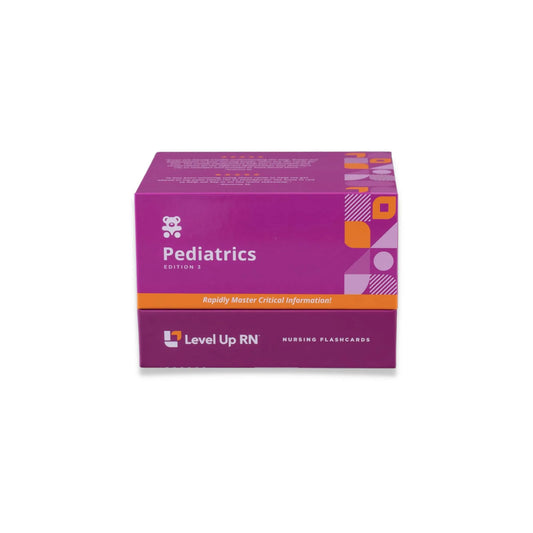Hi, I'm Cathy with Level Up RN. In this video, I'll be discussing a number of childhood cancers from our Level Up RN pediatric nursing flashcards. Specifically, I'll be talking about retinoblastoma, neuroblastoma, and Wilms tumor, which is also known as nephroblastoma. And then at the end of the video, I'm going to give you guys a little quiz to test your understanding of some of the key points I'll be covering, so definitely stay tuned for that. And if you have our Level Up RN flashcards, go ahead and pull out your flashcards so you can follow along with me.
Retinoblastoma is the most common intraocular cancer in childhood. This type of cancer is caused by a gene mutation that causes the cells in the retina to grow out of control. This type of cancer is most common in children under three, and signs and symptoms include leukocoria, which is where the pupil appears white, as well as strabismus, which is often referred to as a lazy eye, vision issues, as well as eye pain, swelling, and redness. Diagnosis of retinoblastoma includes a comprehensive eye examination as well as imaging with an ultrasound, CT, and/or MRI. Treatment may include chemotherapy, cryotherapy, which involves freezing of the retinoblastoma cells, radiation, laser therapy, or surgery to remove the eye, which is called enucleation. So if the child does require enucleation, they will be fitted for a prosthetic eye. And an ocularist will provide instructions on removal, insertion, and cleaning of the prosthesis.
Next, we have neuroblastoma, which is a cancer of the sympathetic nervous system and is most frequently found in the adrenal gland. So this cancer develops in the neuroblasts, which are immature nerve cells, and it is most common in children under the age of five. So early signs and symptoms of this type of cancer are often vague or similar to the symptoms of other childhood illnesses such as fever, fatigue, decreased appetite, and weight loss. And because of the vagueness of these symptoms, this type of cancer often metastasizes prior to diagnosis. As the disease progresses, signs and symptoms can include a lump or swelling in the abdomen as well as bone pain. Diagnosis may involve a number of imaging tests, such as an ultrasound, CT, MRI, and bone scan, just to name a few. And then a biopsy would be used to confirm diagnosis of neuroblastoma. Treatment may include chemotherapy, surgical removal of the tumor, radiation, as well as a stem cell transplant.
And then finally, we're going to talk about Wilms tumor, which is also known as nephroblastoma. This is the most common renal cancer of childhood and primarily affects children under the age of five. It is more common in African Americans and slightly more common in females versus males. Signs and symptoms include a firm, painless mass in the abdomen, which will be located toward the flank or side, as well as fever, fatigue, hypertension, and hematuria, which is where we have blood in the urine. Diagnostic tests may include an ultrasound, CT, and/or MRI, as well as an X-ray to check for spread of cancer to the lungs. And then a biopsy would provide definitive diagnosis of Wilms tumor. Treatment options include a nephrectomy, which is surgical removal of the kidney, as well as chemotherapy and radiation. And then one very important thing I want to mention and something that nursing exams love to ask about is that when you are caring for a child with Wilms tumor, you absolutely do not want to palpate the mass in their abdomen because this can cause the cancer to spread.
All right. It's quiz time, and I've got three questions for you.
Question number one. Leukocoria is a sign of what childhood cancer?
The answer is retinoblastoma.
Question number two. Why does neuroblastoma often metastasize prior to diagnosis?
The answer is because these symptoms are often initially vague, such as fever, fatigue, and decreased appetite.
Question number three. Why should you avoid palpating the abdomen of a patient with Wilms tumor?
The answer is because it can cause the cancer to spread. And you probably knew I was going to ask about that, didn't you?
All right. That is it for this video. I hope you found it to be helpful. Take care and good luck with studying.


